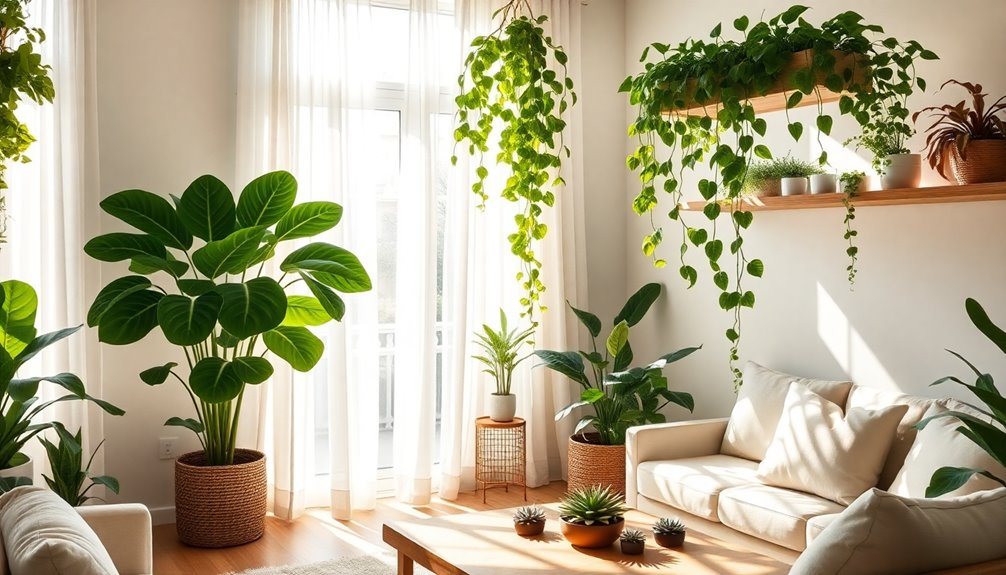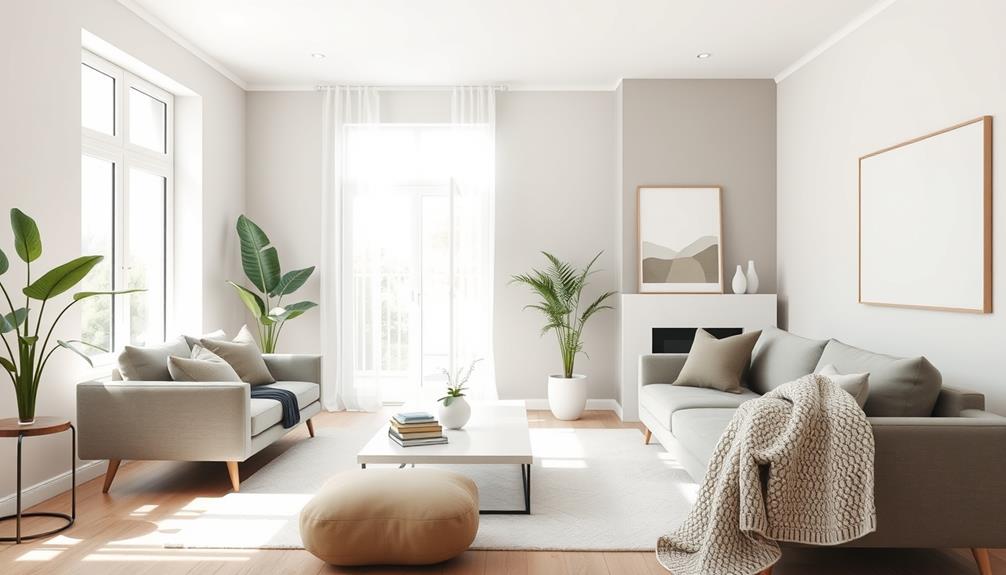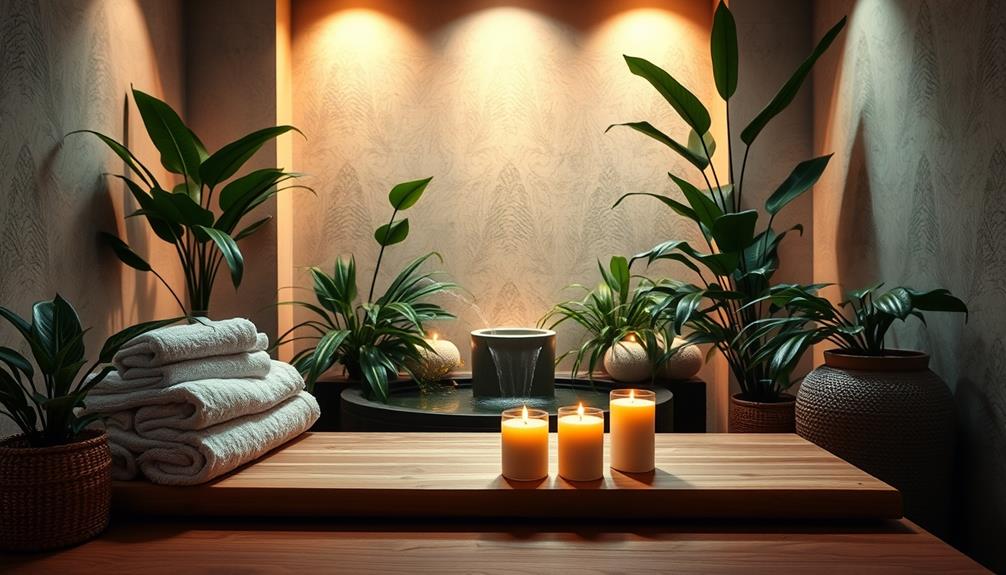Indoor plants greatly enhance your home’s air quality while adding a vibrant touch to your decor. They absorb harmful pollutants like formaldehyde and benzene, creating a healthier environment. Plus, the aesthetic appeal of plants can elevate your mood and boost productivity. You’ll find that incorporating low-maintenance varieties can be effortless and rewarding. Curious about which plants work best and how to care for them? There’s so much more to explore on this journey!
Key Takeaways
- Indoor plants improve air quality by absorbing harmful pollutants like formaldehyde and benzene, contributing to a healthier living environment.
- Aesthetic appeal of houseplants enhances home decor, adding vibrant colors and textures that transform spaces into inviting oases.
- Plants boost mood and well-being, creating a calming atmosphere that can increase productivity by up to 20%.
- Proper placement and maintenance of indoor plants optimize their air-purifying benefits while ensuring a safe environment for pets.
- Incorporating low-maintenance plants, like Snake Plants, simplifies care while still significantly improving indoor air quality and enhancing decor.
Importance of Indoor Air Quality
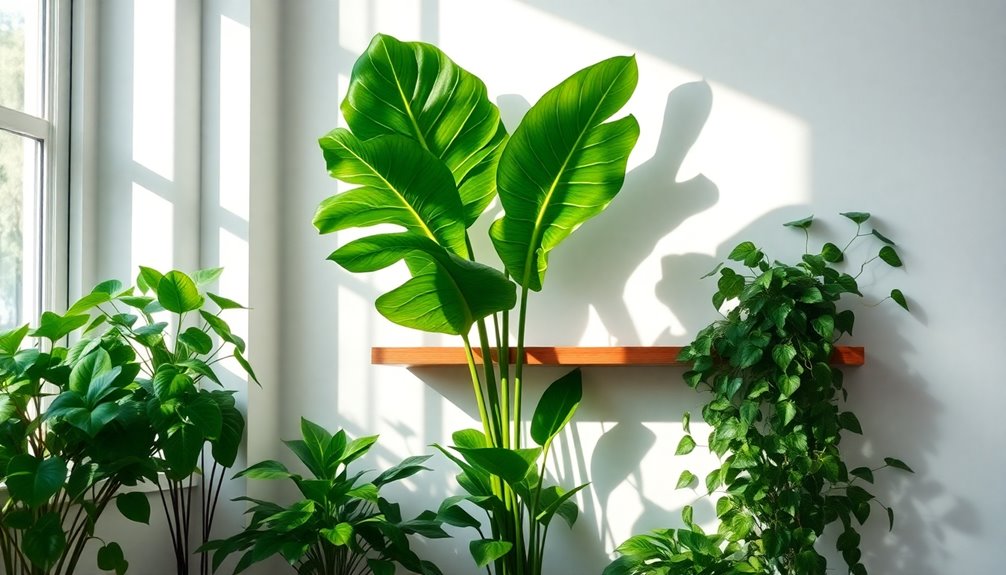
Indoor air quality is vital for your health, especially since everyday pollutants like VOCs and allergens can lead to headaches and respiratory issues.
You mightn’t realize it, but the air inside your home can be more polluted than outside. Common air pollutants like formaldehyde and benzene can linger in the air, affecting your well-being.
Incorporating houseplants into your space can greatly improve air quality. Studies show that certain houseplants can absorb these toxins and help clean the air, creating a healthier indoor environment.
By adding greenery, you not only beautify your home but also combat eye irritation and respiratory problems. Moreover, ensuring optimal ventilation and using efficient wood stoves can further enhance indoor air quality by reducing harmful emissions.
Prioritizing indoor air quality is essential for maintaining your overall health and enhancing your daily productivity.
Science Behind Houseplants and Air Purification
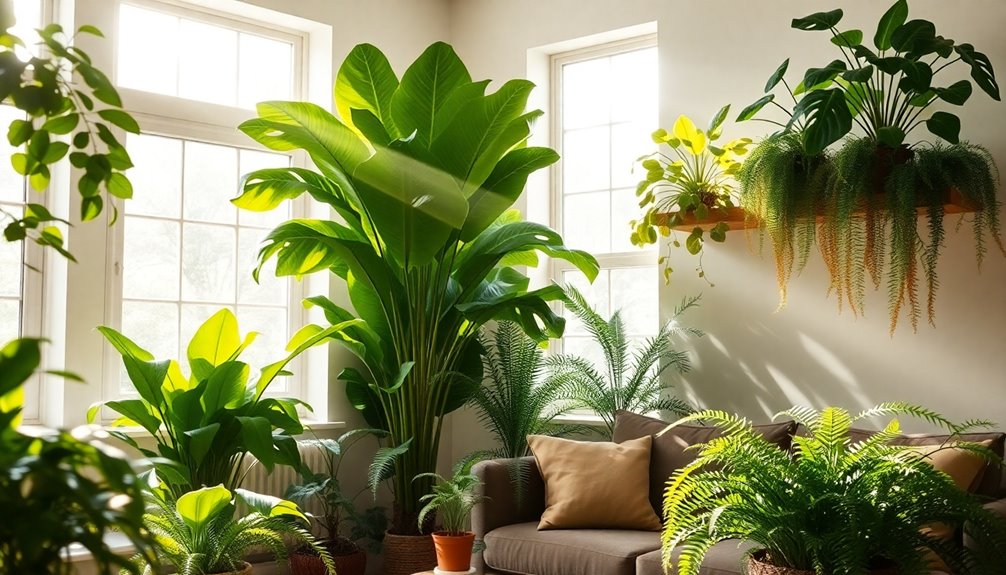
Understanding how houseplants purify the air can transform your indoor space.
Through a process called phytoremediation, specific plants like spider plants and peace lilies actively absorb harmful pollutants.
Plus, soil microorganisms play an essential role in enhancing this natural air-cleaning capability, making your green companions even more effective. Additionally, incorporating renewable energy sources into your home can further improve air quality by reducing reliance on fossil fuels.
Phytoremediation Mechanism Explained
While many people appreciate the aesthetic appeal of houseplants, their role in improving air quality through phytoremediation is equally important.
Phytoremediation involves plants absorbing, accumulating, and detoxifying harmful indoor air pollutants, primarily through their leaves and roots. A NASA study highlighted certain plants, like the spider plant and peace lily, as effective at removing volatile organic compounds (VOCs) such as formaldehyde and benzene from indoor environments.
The roots and associated soil microorganisms enhance air purification by breaking down toxins into less harmful substances. Research shows that certain plants can eliminate up to 50% of formaldehyde, considerably improving indoor air quality. Additionally, combining plants with HEPA filters can significantly enhance the overall air purification process in indoor spaces.
For the best results, verify your plants are healthy and well-maintained, as stressed plants are less efficient in removing pollutants.
Effective Plants for Purification
Houseplants like the spider plant and snake plant aren’t just beautiful additions to your home; they play an essential role in purifying the air you breathe.
These common houseplants are effective at removing airborne pollutants, greatly improving indoor air quality.
Here are three effective plants for purification:
- Spider Plant: Great at removing formaldehyde and other toxins.
- Snake Plant: Known for its ability to absorb benzene and formaldehyde.
- Peace Lily: Excellent at filtering out ammonia and other harmful chemicals.
In addition to their purifying qualities, many of these plants, such as the Areca Palm, are also non-toxic to pets, making them great choices for households with animals.
Soil Microorganisms’ Role
The air-purifying abilities of plants are considerably enhanced by the presence of soil microorganisms. These beneficial bacteria and fungi play a crucial role in phytoremediation, breaking down pollutants and improving indoor air quality.
When you care for your indoor plants, you’re also nurturing a thriving community of soil microorganisms in potting soil. This symbiotic relationship allows plants to absorb nutrients and toxins more effectively, enhancing their capacity to filter out harmful volatile organic compounds like formaldehyde and benzene.
As microbial activity adapts over time, your plants’ air-cleaning efficiency improves, continuously combating airborne toxins. By fostering healthy soil microbiomes, you support both plant growth and a cleaner indoor environment, making your home not just beautiful, but also healthier. Additionally, proper diet for your plants, including the right type of fertilizer, can further enhance microbial activity and plant health.
Benefits of Houseplants in Home Decoration
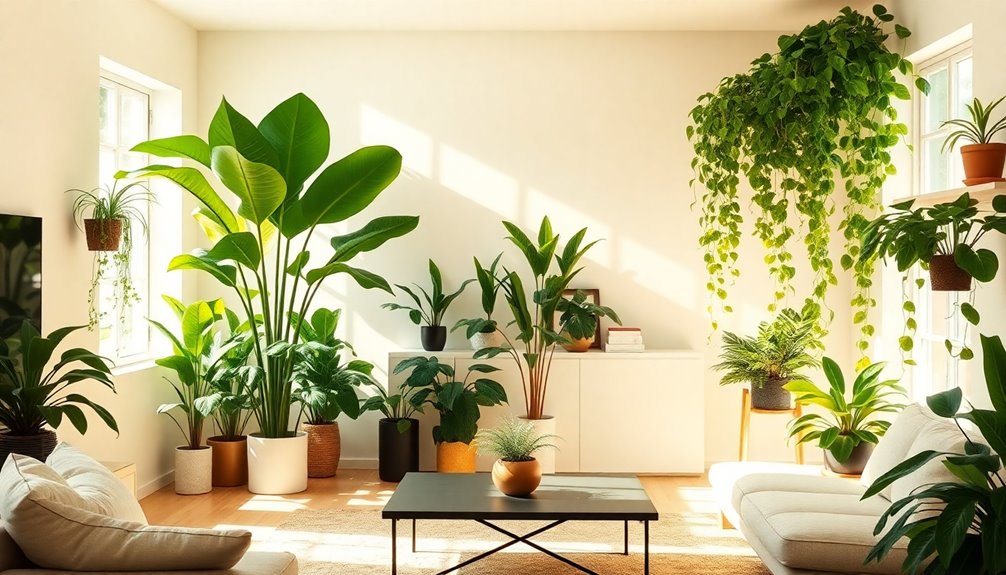
Houseplants can transform your space by adding vibrant colors and textures, making your home feel more inviting.
They not only boost your mood but also help create a sense of well-being, connecting you to nature.
Plus, with the right placement, plants can enhance spatial design, making even the simplest rooms feel more organized and harmonious. Additionally, incorporating feline-friendly houseplants can ensure a safe environment for pet owners while still enjoying the aesthetic benefits of greenery.
Aesthetic Appeal Enhancement
How can you transform your living space into a vibrant oasis? Incorporating indoor plants can greatly enhance your home’s aesthetic appeal. They add vibrant colors and textures, creating a visually pleasing environment that draws attention and serves as natural art pieces.
Here are three ways to use houseplants for versatile decoration:
- Focal Points: Place tall plants like Fiddle Leaf Figs in corners to create stunning focal points.
- Small Spaces: Use small succulents on shelves or desks to add greenery without overwhelming the area.
- Calming Atmosphere: Choose plants like Peace Lilies to not only beautify your room but also promote a calming atmosphere. Additionally, selecting non-toxic large houseplants ensures a safe environment for your pets while enhancing your decor.
With the right selection, your indoor plants can elevate your decor while enhancing your overall living experience.
Mood and Well-being Boost
Incorporating indoor plants not only beautifies your space but also plays a pivotal role in enhancing your mood and well-being.
Studies show that having plants around can greatly reduce stress and anxiety, leading to a happier atmosphere. This positive change in mood can boost your productivity by up to 20%, making your home a more effective space for work and relaxation.
Additionally, the aesthetic appeal of these plants transforms your decor into a vibrant environment that invites comfort. They also improve indoor air quality by absorbing toxins and releasing oxygen, creating a fresher living area. Furthermore, proper nutrition is essential for emotional well-being, which can be supported by creating a calming home environment filled with greenery.
Space Utilization and Organization
Transforming your home with indoor plants not only adds beauty but also optimizes space utilization and organization.
Houseplants bring life and color to dull areas, enhancing your indoor environments. Here’s how they can help:
- Natural Dividers: Use tall plants to create visual separation between rooms, improving organization and flow.
- Vertical Gardens: Incorporate wall-mounted planters to maximize floor space, perfect for smaller homes or urban dwellers.
- Personalized Decor: Choose plants that complement your style, from modern minimalism to bohemian, while enjoying the benefits of improved air quality and natural air. Additionally, selecting nectar-rich plants can further enhance your home atmosphere by attracting beneficial pollinators indoors.
Best Houseplants for Purifying Indoor Air
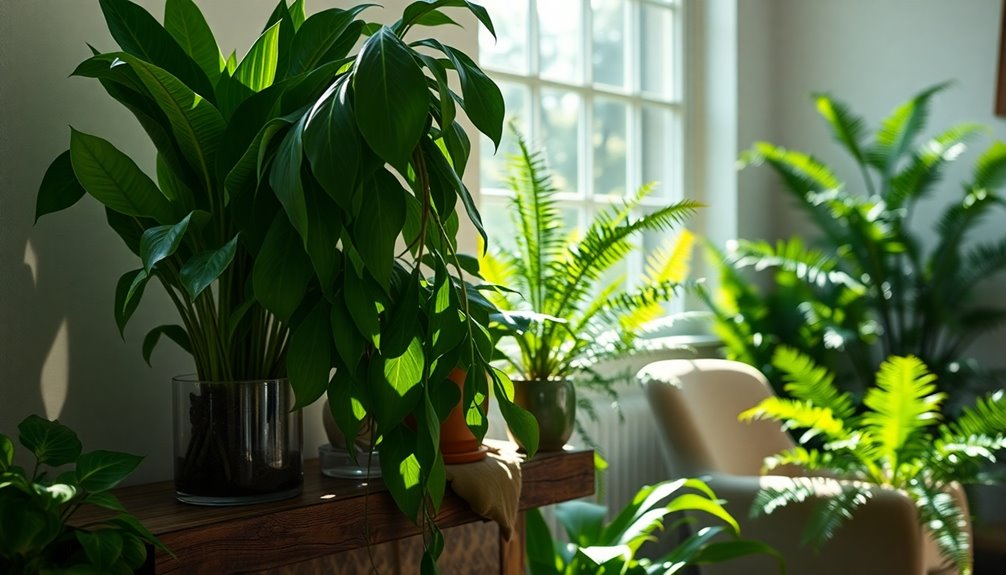
Although many people overlook the importance of indoor plants, choosing the right ones can greatly enhance your home’s air quality. Here are some of the best houseplants for purifying indoor air:
| Plant | Benefits |
|---|---|
| Spider Plant | Removes formaldehyde and xylene; easy to propagate |
| Snake Plant | Filters benzene and formaldehyde; produces oxygen at night |
| Peace Lily | Effective against ammonia and benzene; adds aesthetic appeal |
| Aloe Vera | Purifies air from formaldehyde and benzene; skin-healing properties |
| English Ivy | Reduces airborne fecal-matter particles; filters formaldehyde |
Incorporating these plants into your home isn’t just about decoration; it’s a smart choice for a healthier living environment, as they can complement HEPA filtration systems that further improve indoor air quality.
How to Incorporate Houseplants for Maximum Benefit
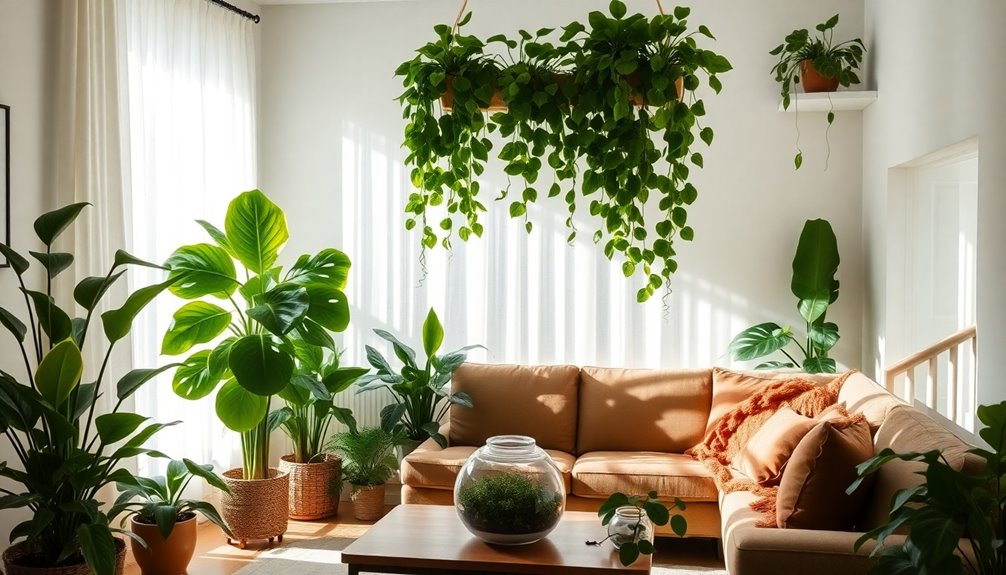
To achieve maximum benefit from houseplants, start by evaluating your home’s layout and light conditions. This guarantees your plants receive ideal sunlight, enhancing their air-purifying capabilities.
Here are three tips to incorporate houseplants effectively:
- Placement: Choose one healthy plant per 100 square feet of living space to greatly improve air quality.
- Selection: Opt for low-maintenance plants like Snake Plants or ZZ Plants, which require less care while still purifying the air.
- Maintenance: Regularly water, choose the right soil, and prune your plants to keep them healthy and maximize their air-cleaning potential.
Understanding Your Space and Plant Selection

When selecting houseplants, understanding your space is essential for ensuring both aesthetic appeal and ideal growth.
Start by evaluating the lighting conditions; some plants, like snake plants, thrive in low light while succulents need bright sunlight.
Next, evaluate the humidity levels in your environment—tropical plants such as peace lilies require more moisture than hardy cacti.
Assess your humidity levels, as tropical plants like peace lilies need more moisture than resilient cacti.
Consider the size of your plants; a large fiddle leaf fig can be a stunning focal point, while smaller pothos fit perfectly on shelves.
Your plant selection shouldn’t only match your aesthetic preferences but also enhance air quality—spider plants, for example, remove formaldehyde.
Finally, choose options that align with your maintenance capabilities, like low-maintenance ZZ plants for busy lifestyles.
Plant Care and Maintenance for Optimal Air Quality
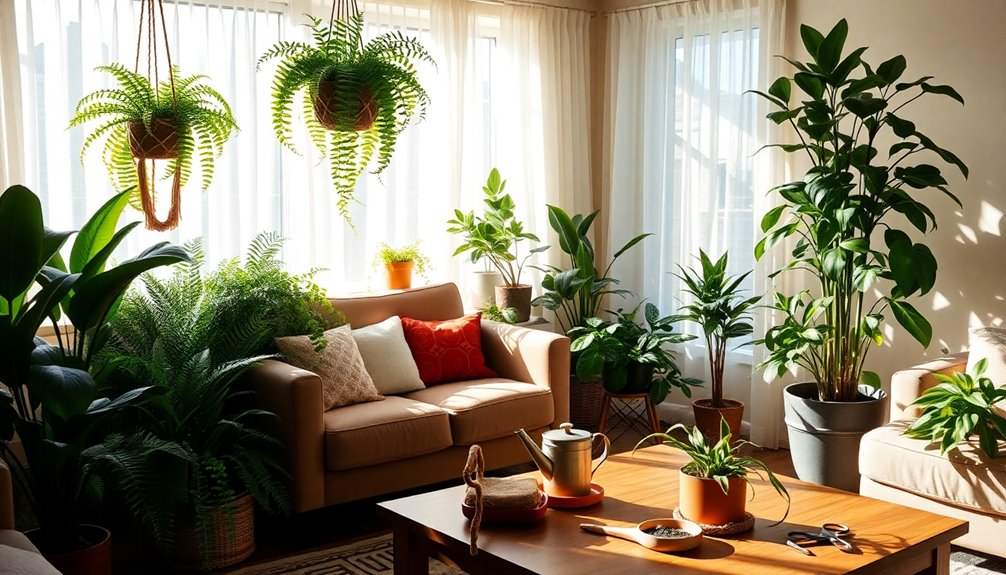
Choosing the right plants for your space is just the beginning; caring for them properly is what truly maximizes their air-purifying potential.
Regular plant care and maintenance are essential for keeping your houseplants healthy, which directly impacts indoor air quality.
Here are three key tips:
- Water and Fertilize: Make certain your plants receive appropriate water and nutrients to thrive.
- Clean Leaves: Wipe leaves with a damp cloth to enhance light absorption and reduce dust, boosting their ability to purify the air.
- Monitor Soil Health: Healthy soil microorganisms improve the breakdown of airborne pollutants, enhancing your plants’ air-cleaning capabilities.
Common Misconceptions About Houseplants and Air Quality
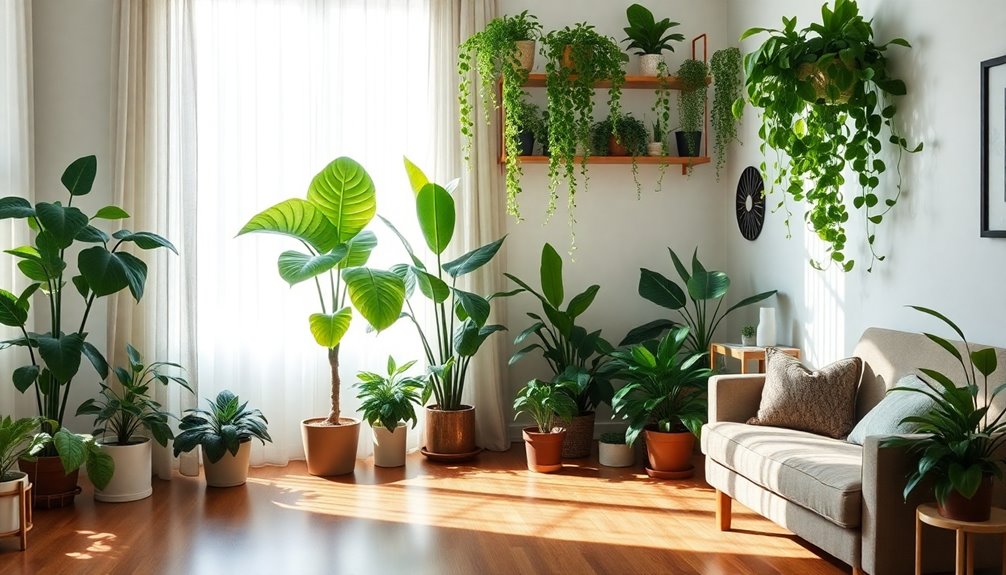
Many people mistakenly believe that simply adding houseplants can greatly improve indoor air quality. While houseplants do play a role, studies reveal that you may need 10 to 1,000 plants per square meter to considerably reduce VOCs.
Furthermore, research shows houseplants often don’t effectively purify air in typical homes, as many studies were conducted in controlled environments. To truly enhance air quality, you should prioritize proper ventilation and minimize VOC-emitting products.
Additionally, overwatering can lead to mold growth, worsening respiratory issues. Dust accumulation on leaves can also exacerbate problems, so regular maintenance is essential.
Understanding these misconceptions helps you create a healthier indoor environment by combining houseplants with practical strategies.
Additional Benefits of Houseplants Beyond Air Purification
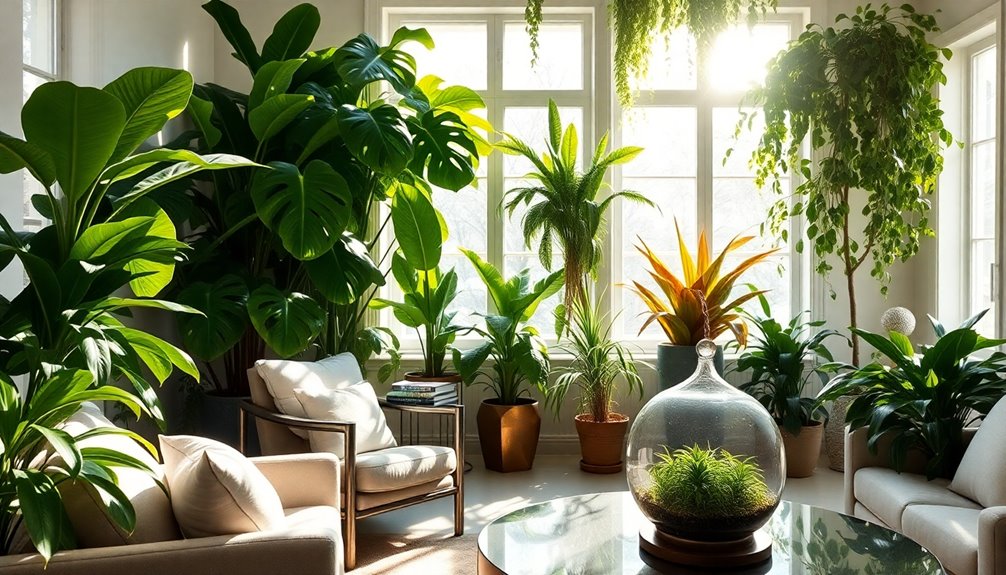
While houseplants are often recognized for their air-purifying qualities, their benefits extend far beyond that. Incorporating greenery into your space can greatly enhance your environment in several ways:
- Boost Mood: Studies show that having plants can increase your overall well-being by 15%, reducing stress and enhancing your mood.
- Enhance Productivity: Plants can elevate creativity and focus, leading to a 12% increase in productivity, making them perfect for workspaces.
- Improve Humidity: Through transpiration, houseplants release moisture, helping to alleviate dry skin and respiratory issues.
Additionally, calming scents from plants like lavender promote relaxation, while their aesthetic benefits create a more inviting atmosphere, contributing to better air quality and a beautiful home.
Frequently Asked Questions
Do Houseplants Improve Indoor Air Quality?
Yes, houseplants can improve indoor air quality. They absorb various pollutants through their leaves and roots, effectively filtering harmful substances like formaldehyde and benzene.
By placing one healthy plant per 100 square feet, you maximize their air-purifying abilities.
Keep in mind that while plants help, they shouldn’t be your only solution. Regular ventilation and cleaning are essential to achieve the best results in maintaining a healthy indoor environment.
What Is the Role of Plants in Home Decoration?
Plants play a significant role in home decoration by adding vibrant colors and textures to your space.
You can use them as focal points or subtle accents, enhancing the overall aesthetic of your rooms. By selecting various species based on size and shape, you’ll create a personalized look that reflects your style.
Incorporating plants also brings a sense of warmth and tranquility, making your home feel more inviting and connected to nature.
What Plant Removes 78% of Airborne Mold?
Think of the Peace Lily as a silent guardian of your home, quietly battling airborne mold.
This remarkable plant can reduce mold spores by up to 78%, making it an essential ally in your indoor environment.
Not only does it tackle mold, but it also filters out harmful pollutants like ammonia and benzene.
With minimal care, the Peace Lily thrives in low light, effortlessly enhancing your space while improving air quality.
What Role Do Plants Play in Improving Air Quality?
Plants play an essential role in improving air quality by filtering out harmful pollutants from your indoor environment. They absorb toxins like formaldehyde and benzene, helping to create a healthier atmosphere.
By adding a few houseplants in your space, you’re not just enhancing the aesthetic; you’re also promoting better air.
Just remember, keeping those plants well-watered and their leaves clean maximizes their effectiveness in purifying the air you breathe daily.
Conclusion
Incorporating indoor plants into your home isn’t just about decoration; it’s a chance to breathe easier and feel more vibrant. You’ll find that the right plants can transform your space while purifying the air you share with family and friends. As you nurture them, they’ll nurture you in return, creating a harmonious environment. So, why not take a step towards a healthier, more beautiful home today? You might be surprised by how much joy and freshness they bring!
